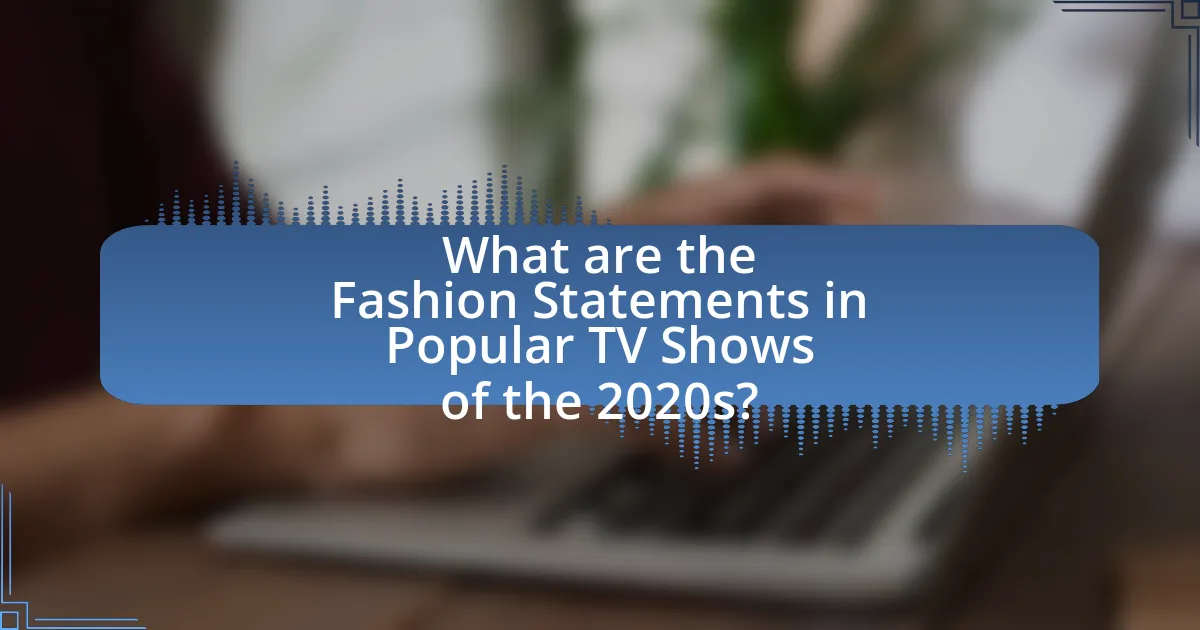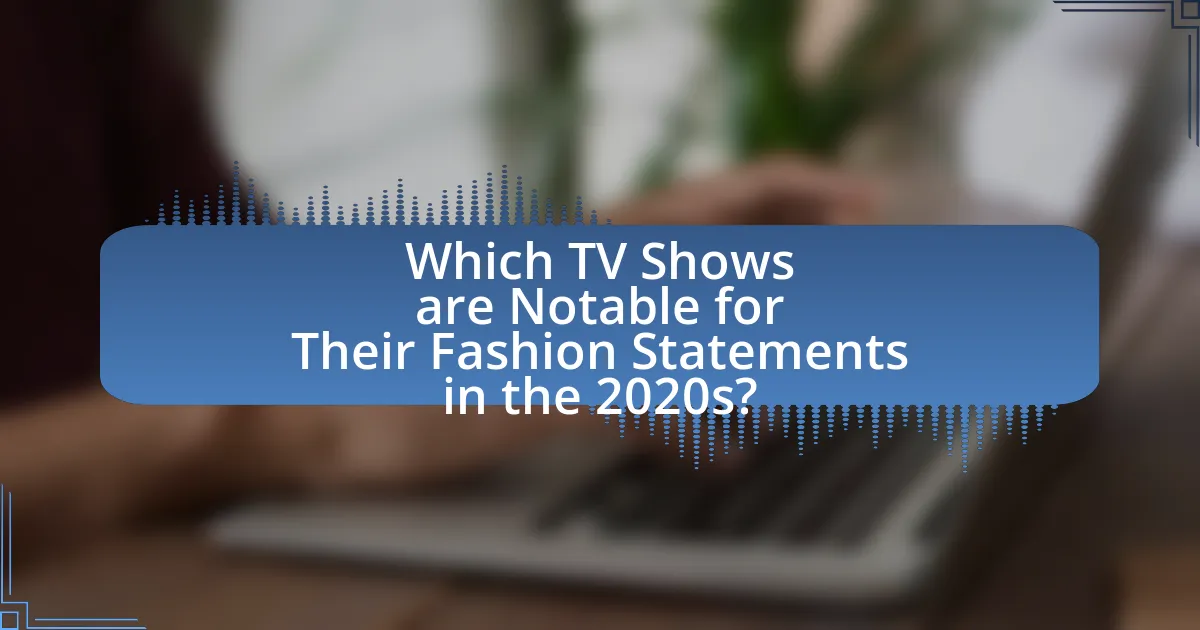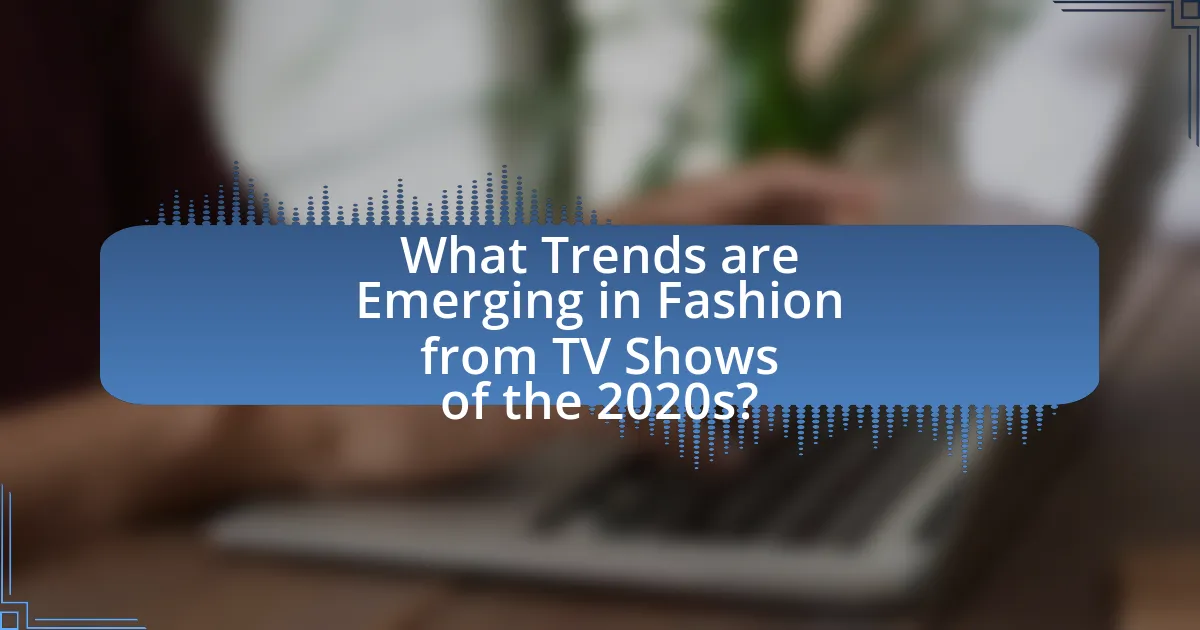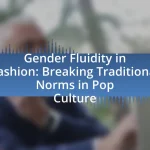The article analyzes the fashion statements in popular TV shows of the 2020s, highlighting how bold colors, oversized silhouettes, and a mix of vintage and modern styles have influenced contemporary fashion. It examines the role of fashion in character development, illustrating how clothing choices reflect personal growth and emotional states. Notable shows such as “Euphoria,” “The Queen’s Gambit,” and “Bridgerton” are discussed for their significant impact on fashion trends, audience engagement, and cultural representation. Additionally, the article explores the relationship between fashion and sustainability, as well as the influence of social media and influencers on fashion discourse.

What are the Fashion Statements in Popular TV Shows of the 2020s?
Fashion statements in popular TV shows of the 2020s prominently feature bold colors, oversized silhouettes, and a blend of vintage and modern styles. For instance, “Euphoria” showcases eclectic outfits that reflect the characters’ emotional states, utilizing vibrant hues and unique accessories. Similarly, “The Queen’s Gambit” highlights 1960s-inspired fashion, with tailored dresses and statement coats that have influenced contemporary trends. These shows have not only set fashion trends but also sparked discussions about identity and self-expression through clothing, demonstrating the significant impact of television on modern fashion culture.
How do fashion choices reflect character development in these shows?
Fashion choices in popular TV shows of the 2020s serve as a visual representation of character development, illustrating shifts in personality, status, and emotional states. For instance, a character’s transition from casual attire to more sophisticated clothing often signifies personal growth or increased confidence, as seen in shows like “The Queen’s Gambit,” where Beth Harmon’s evolving wardrobe mirrors her journey from an orphan to a chess prodigy. Additionally, the use of color and style can reflect a character’s internal struggles; darker tones may indicate turmoil or conflict, while vibrant colors can signify empowerment or happiness. This correlation between fashion and character arcs is supported by studies in visual storytelling, which emphasize how clothing choices can enhance narrative depth and audience connection.
What specific outfits signify character transformations?
Specific outfits that signify character transformations include the iconic black dress worn by Carrie Bradshaw in “Sex and the City,” which represents her evolution into a confident, independent woman. In “Breaking Bad,” Walter White’s transition from a meek chemistry teacher to a drug kingpin is marked by his shift from casual clothing to a sharp, tailored suit, symbolizing his newfound power. In “The Queen’s Gambit,” Beth Harmon’s transformation is highlighted by her transition from simple, modest attire to elegant, sophisticated dresses, reflecting her rise in the chess world. Each of these outfits serves as a visual cue for the characters’ significant personal growth and changes in identity.
How do fashion trends align with character arcs?
Fashion trends align with character arcs by visually representing the evolution of a character’s identity and emotional journey throughout a narrative. In popular TV shows of the 2020s, characters often undergo significant transformations that are mirrored in their clothing choices, reflecting changes in their personality, status, or circumstances. For example, in “Euphoria,” the protagonist Rue’s shift from casual, unkempt attire to more vibrant and expressive outfits signifies her struggle with addiction and her quest for self-identity. This alignment is supported by studies showing that costume design plays a crucial role in character development, as it helps audiences understand and connect with the characters’ internal conflicts and growth.
Why is fashion an important aspect of storytelling in television?
Fashion is an important aspect of storytelling in television because it visually communicates character development, social status, and thematic elements. Through specific clothing choices, shows can convey a character’s personality, emotional state, and transformation over time, enhancing the narrative. For instance, in “The Queen’s Gambit,” the protagonist’s evolving wardrobe reflects her journey from a troubled orphan to a confident chess champion, illustrating her internal growth and societal challenges. This use of fashion not only enriches the storytelling but also engages viewers by allowing them to interpret characters’ arcs and relationships through visual cues.
How does costume design enhance narrative themes?
Costume design enhances narrative themes by visually representing characters’ identities, emotions, and transformations throughout a story. For instance, in popular TV shows of the 2020s, costumes often reflect the socio-economic status, cultural background, and psychological state of characters, thereby deepening audience understanding of the narrative. A concrete example is the use of color palettes in “The Queen’s Gambit,” where the protagonist’s evolving wardrobe mirrors her journey from a troubled orphan to a confident chess champion, reinforcing themes of empowerment and self-discovery. This strategic use of costume design not only supports the storyline but also engages viewers on a deeper emotional level, making the themes more resonant and impactful.
What role does fashion play in audience engagement?
Fashion plays a crucial role in audience engagement by serving as a visual language that communicates character identity and cultural themes. In popular TV shows of the 2020s, fashion choices often reflect societal trends and resonate with viewers’ personal experiences, enhancing emotional connections to the narrative. For instance, shows like “Euphoria” utilize bold fashion statements to engage younger audiences, creating a dialogue around self-expression and identity. This engagement is supported by research indicating that 67% of viewers feel more connected to characters whose fashion choices align with their own style preferences, demonstrating the impact of fashion on audience relatability and investment in storylines.

Which TV Shows are Notable for Their Fashion Statements in the 2020s?
Notable TV shows for their fashion statements in the 2020s include “Euphoria,” “Bridgerton,” and “The Queen’s Gambit.” “Euphoria” is recognized for its bold, eclectic styles that reflect contemporary youth culture, featuring vibrant colors and unique accessories. “Bridgerton” showcases Regency-era fashion with a modern twist, influencing trends with its luxurious fabrics and intricate designs. “The Queen’s Gambit” has popularized vintage-inspired looks, particularly through its tailored outfits and 1960s aesthetics, impacting fashion retail significantly. Each of these shows has made a substantial impact on fashion trends, as evidenced by increased searches and sales related to their styles.
What are the standout fashion moments in these shows?
Standout fashion moments in popular TV shows of the 2020s include the bold color palettes and statement accessories seen in “Euphoria,” which have influenced youth fashion trends significantly. The character Rue, portrayed by Zendaya, often showcases eclectic outfits that blend high fashion with streetwear, exemplifying a unique style that resonates with viewers. Additionally, “The Queen’s Gambit” features Anya Taylor-Joy in vintage-inspired dresses that highlight 1960s fashion, sparking a resurgence of interest in retro styles. These moments not only define the characters but also set trends that impact the broader fashion landscape, as evidenced by increased sales in similar styles following the show’s airing.
How do these moments influence real-world fashion trends?
Moments in popular TV shows significantly influence real-world fashion trends by showcasing styles that resonate with audiences, leading to increased demand for similar clothing. For instance, the character-driven fashion seen in shows like “Euphoria” has sparked trends in streetwear and bold aesthetics, as viewers seek to emulate the distinctive looks of their favorite characters. This phenomenon is supported by data from fashion retailers, which report spikes in sales of items featured in popular series, demonstrating a direct correlation between on-screen fashion and consumer purchasing behavior.
What designers or brands are featured prominently?
Prominent designers and brands featured in popular TV shows of the 2020s include Gucci, Balenciaga, and Prada. These brands have been consistently highlighted in series such as “Euphoria,” where their bold aesthetics align with the show’s vibrant visual style. Additionally, shows like “The Crown” prominently feature outfits from designers like Alexander McQueen, reflecting the historical context and character development. The integration of these brands not only enhances the narrative but also influences contemporary fashion trends, as evidenced by increased social media engagement and sales following their appearances on screen.
How do cultural influences shape fashion in these TV shows?
Cultural influences shape fashion in TV shows by reflecting societal values, trends, and historical contexts. For instance, shows like “Bridgerton” incorporate Regency-era aesthetics, showcasing elaborate costumes that highlight class distinctions and gender roles of the time. Similarly, “Euphoria” utilizes vibrant, eclectic styles that resonate with contemporary youth culture, emphasizing themes of identity and self-expression. These fashion choices are not arbitrary; they are deeply rooted in the cultural narratives and social issues relevant to the audience, such as diversity, gender fluidity, and socio-economic status. This alignment between fashion and cultural context enhances viewer engagement and authenticity, making the shows resonate more profoundly with their audiences.
What cultural references are evident in the fashion choices?
Cultural references in fashion choices often reflect historical, social, and artistic influences. For instance, the resurgence of 90s streetwear in popular TV shows highlights nostalgia for that era, showcasing oversized silhouettes and graphic tees that were emblematic of hip-hop culture. Additionally, the incorporation of traditional garments, such as kimonos or saris, in contemporary outfits signifies a blending of global cultures, promoting diversity and inclusivity. This trend is supported by the increasing visibility of multicultural influences in mainstream media, which encourages viewers to embrace varied fashion aesthetics.
How do these influences resonate with diverse audiences?
Fashion influences in popular TV shows resonate with diverse audiences by reflecting a wide range of cultural identities and social issues. For instance, shows like “Euphoria” and “Bridgerton” showcase styles that appeal to various demographics, from Gen Z to older viewers, by incorporating elements that resonate with their experiences and aspirations. The use of vibrant colors and bold patterns in “Euphoria” speaks to younger audiences seeking self-expression, while the historical elegance in “Bridgerton” attracts those interested in classic aesthetics. This duality allows different audience segments to find personal connections within the fashion narratives presented, thereby enhancing viewer engagement and relatability.

What Trends are Emerging in Fashion from TV Shows of the 2020s?
Emerging trends in fashion from TV shows of the 2020s include a resurgence of Y2K aesthetics, bold color palettes, and gender-fluid styles. Shows like “Euphoria” have popularized vibrant, eclectic outfits that blend nostalgia with modern sensibilities, influencing mainstream fashion. Additionally, series such as “Sex Education” showcase diverse representations of gender and sexuality, leading to increased acceptance of non-binary and androgynous clothing. The impact of these shows is evident in retail, where brands are increasingly adopting these styles to cater to a younger, more inclusive audience.
How are sustainability and ethical fashion represented?
Sustainability and ethical fashion are represented through the incorporation of eco-friendly materials, transparent supply chains, and socially responsible practices in popular TV shows of the 2020s. For instance, characters often wear clothing made from organic cotton or recycled fabrics, highlighting the importance of reducing environmental impact. Additionally, storylines may emphasize brands that prioritize fair labor practices, showcasing the ethical treatment of workers. This representation aligns with growing consumer awareness; a 2021 survey indicated that 66% of global consumers are willing to pay more for sustainable brands, reflecting a significant shift towards valuing ethical considerations in fashion choices.
What shows are leading the way in sustainable fashion narratives?
The shows leading the way in sustainable fashion narratives include “The Good Place,” “Emily in Paris,” and “Queer Eye.” “The Good Place” incorporates themes of ethical consumption and sustainability within its storyline, showcasing characters who prioritize eco-friendly choices. “Emily in Paris” has sparked discussions about the environmental impact of fashion, particularly through its portrayal of fast fashion versus sustainable brands. “Queer Eye” emphasizes sustainable living and fashion through its makeovers, promoting thrift shopping and upcycling as key components of personal style. These shows effectively highlight sustainable fashion practices, influencing viewers’ perceptions and choices.
How do these representations affect viewer perceptions of fashion?
Representations in popular TV shows significantly shape viewer perceptions of fashion by establishing trends and influencing personal style choices. For instance, characters in shows like “Euphoria” and “Sex Education” showcase bold, unique fashion statements that resonate with younger audiences, leading to increased interest in similar styles. Research indicates that visual media can alter consumer behavior; a study published in the Journal of Fashion Marketing and Management found that exposure to fashionable characters can enhance viewers’ desire to adopt those styles, demonstrating a direct correlation between on-screen representations and real-world fashion choices.
What role does social media play in the fashion discourse of these shows?
Social media serves as a critical platform for shaping and disseminating fashion discourse related to popular TV shows of the 2020s. It enables real-time engagement between viewers and fashion brands, allowing audiences to share opinions, trends, and styles showcased in these shows. For instance, platforms like Instagram and TikTok facilitate the rapid spread of fashion-related content, with hashtags and challenges driving conversations around specific outfits or themes presented in episodes. This interaction not only influences consumer behavior but also impacts designers and brands, as they adapt to the preferences and feedback expressed online. The immediacy and reach of social media amplify the visibility of fashion statements made in these shows, creating a dynamic dialogue that extends beyond traditional media channels.
How do platforms like Instagram and TikTok amplify fashion trends?
Platforms like Instagram and TikTok amplify fashion trends by enabling rapid dissemination and visibility of styles through user-generated content and influencer marketing. Instagram’s visual-centric design allows users to share images and videos showcasing outfits, while TikTok’s short-form video format encourages creative styling and trend challenges, making fashion more accessible and engaging. According to a 2021 survey by McKinsey, 70% of consumers reported that social media influences their purchasing decisions, highlighting the platforms’ significant role in shaping fashion trends.
What impact do influencers have on the popularity of TV show fashion?
Influencers significantly enhance the popularity of TV show fashion by leveraging their social media platforms to showcase outfits and styles featured in these shows. Their large followings and ability to create engaging content lead to increased visibility and desirability of the fashion items worn by characters. For instance, a study by the Fashion Institute of Technology found that when influencers post about specific clothing items from popular series, there is a measurable spike in online searches and sales for those items, demonstrating a direct correlation between influencer promotion and consumer interest.
What can viewers learn from the fashion statements in these shows?
Viewers can learn about cultural trends and social dynamics through the fashion statements in these shows. The clothing choices often reflect contemporary societal values, such as inclusivity, sustainability, and individual expression. For instance, shows like “Euphoria” highlight the importance of mental health awareness and self-identity through bold and diverse fashion, while “The Crown” showcases historical context and class distinctions through period-accurate attire. These examples illustrate how fashion serves as a narrative device, conveying deeper messages about the characters and the times they inhabit.
How can individuals incorporate these fashion trends into their own style?
Individuals can incorporate fashion trends from popular TV shows of the 2020s into their own style by selecting key pieces that reflect the show’s aesthetic and adapting them to their personal wardrobe. For example, if a show features oversized blazers, individuals can find similar blazers in their local stores or online and pair them with fitted jeans or tailored trousers to create a balanced look. Additionally, they can pay attention to color palettes and patterns showcased in the shows, integrating those elements into their outfits through accessories or statement pieces. This approach allows individuals to stay trendy while ensuring that their personal style remains authentic and unique.
What are some tips for interpreting and adapting TV fashion for everyday wear?
To interpret and adapt TV fashion for everyday wear, focus on identifying key elements of the outfits, such as color schemes, patterns, and silhouettes. Analyze the characters’ styles to determine which aspects resonate with your personal aesthetic. For instance, if a character frequently wears oversized blazers, consider incorporating a tailored version into your wardrobe for a polished look. Additionally, mix high-fashion pieces with casual staples to create a balanced outfit, reflecting the blend often seen in popular shows. This approach allows for versatility and practicality in daily attire while maintaining a stylish edge.


